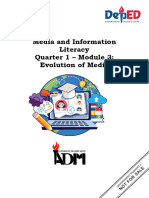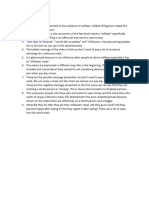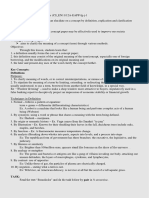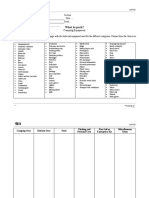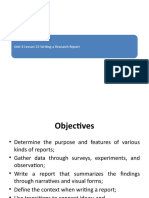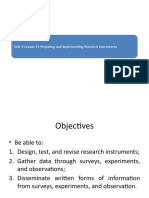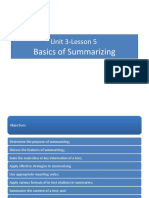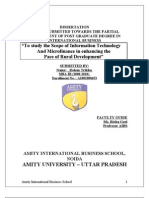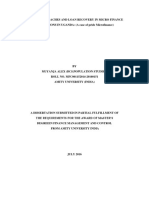0 ratings0% found this document useful (0 votes)
392 viewsUnit 3-Lesson 6-Paraphrasing-Direct Quoting
This document provides instruction on paraphrasing, direct quoting, and summarizing texts. It defines each technique and differentiates between them. Paraphrasing involves restating a text in one's own words while maintaining the original meaning, whereas direct quoting involves copying a text verbatim using quotation marks. Summarizing involves condensing a text down to its main ideas in one's own words. The document provides guidelines for when to use each technique as well as tips for paraphrasing, quoting, and citing sources correctly. Students are given examples to practice paraphrasing and directed to conduct research using quotes and paraphrases.
Uploaded by
Dale Jose GarchitorenaCopyright
© © All Rights Reserved
Available Formats
Download as PPTX, PDF, TXT or read online on Scribd
0 ratings0% found this document useful (0 votes)
392 viewsUnit 3-Lesson 6-Paraphrasing-Direct Quoting
This document provides instruction on paraphrasing, direct quoting, and summarizing texts. It defines each technique and differentiates between them. Paraphrasing involves restating a text in one's own words while maintaining the original meaning, whereas direct quoting involves copying a text verbatim using quotation marks. Summarizing involves condensing a text down to its main ideas in one's own words. The document provides guidelines for when to use each technique as well as tips for paraphrasing, quoting, and citing sources correctly. Students are given examples to practice paraphrasing and directed to conduct research using quotes and paraphrases.
Uploaded by
Dale Jose GarchitorenaCopyright
© © All Rights Reserved
Available Formats
Download as PPTX, PDF, TXT or read online on Scribd
You are on page 1/ 16
Unit 3-Lesson 6
PARAPHRASING & DIRECT QUOTING
Objectives
• Identify features of paraphrasing and direct quoting;
• Differentiate summarizing, paraphrasing and direct
quoting;
• Use appropriate reporting verbs;
• Paraphrase various texts;
• Write direct quotations;
• Apply various forms of in-text citations in
paraphrases and direct quotes; and
• Evaluate paraphrases and direct quotations.
Warm up Activity
• As groups with five members each, pick one
English song and paraphrase its lyrics.
• Then submit a copy of the original lyrics and
the paraphrased version.
• For better appreciation of the activity, each
group shall sing to class the original song
which lyrics they paraphrased.
Summarizing, Paraphrasing and Direct Quoting compared
• While they are all skills that help effectively
encapsulate ideas or concepts in a text, these three
have the following similarities and differences:
• Summarizing: 1) does not match the source word
for word;
2) Involves putting the main idea in
one’s own words;
3) Much shorter than the original
text;
Similarities and Differences
• Must be attributed to the original source.
• Paraphrasing: 1) does not match the source word
for word;
2) putting a passage in one’s own
words;
3) changes the words or phrases in
a passage but retains and
communicates its original meaning;
4) attributed to the original source.
Similarities and Differences
• Direct Quoting: 1) matches the source word
for word;
2) usually a short part of the
text;
3) cited parts are enclosed in
quotation marks;
4) must be attributed to the
original source
When to Use Paraphrasing, Summarizing & Direct Quoting
• We paraphrase a short text with one or two
sentences, or a paragraph with a maximum of
five sentences;
• We paraphrase when we avoid or minimize
direct quotation; or
- to rewrite the author’s words by not changing
the message, or
- to use you own words to state the author’s ideas
• We summarize a text that has long sections;
• We also summarize when we want to:
- avoid or minimize direct quotation; or
- use the main idea of the text and write it in
your own words.
• We quote a text that conveys powerful
message, or will show less impact if it is
paraphrased or summarized (e.g., Constitution)
• We quote directly when we want to:
- begin our discussion with the author’s stand;
or
- highlight the author’s expertise in your claim,
argument or discussion.
Guidelines in Paraphrasing
1. Read the text and understand its meaning. Do not
stop until you understand the message.
2. Use pen to highlight or underline the key words or
main idea of the text.
3. Recall the key words or main idea of the text that you
highlighted when you read it.
4. Write in your own words what you understood about
the ideas in the text.
5. Get the original text and compare it with your
paraphrase.
Guidelines in Paraphrasing
6. Check the meaning to be sure that the paraphrase
should have the same meaning as the original text.
7. Refrain from adding comments about the text.
8. Compare your output to the original text to ensure
accuracy and remove redundant words or ideas.
9. Record details of the original source (author,
publication date, etc. Or URL if on-line.
10. Format your paraphrase properly.
Guidelines in Direct Quoting
• Warning : Direct quoting should not be used
to replace paraphrasing or summarizing.
1. Copy exactly the part of the text that you
want to use.
2. Use quotation marks to show the beginning
and ending of the quote.
3. Record the details of the original source;
4. Format your quotation properly.
Reinforcement Activity
• Conduct a research about any of the two controversial
topics below:
1. The Tax Reform for Acceleration and Inclusion (TRAIN)
Law ;
2. Anti-Hospital Bill Deposit Law (R.A. 10932).
• Write an information article about your chosen topic in
500 to 700 words.
• Make sure to add direct quotations and paraphrased
material to expound on your topic.
• Cite your sources.
Class Activity
• In a sheet of paper, highlight the key words or
phrases in the original texts and write your
paraphrases.
• “Corruption occurs in both public and private
organizations. It can be understood as a decision
“sold” to benefit the briber, while the bribe
payment compensates for the decision maker’s risks
and moral cost of betraying the institution”
(Sorelde, 2014, p.1)
• Use the Date Heading Format in your paraphrase.
• “Microfinance is the provision of financial intermediation
through the distribution of small loans, acceptance of
small savings and provision of other financial products
and services to the poor. Central to the concept of
microfinance is the idea that poverty can be effectively
and permanently reduced or eliminated within a
reasonable period of time by providing the poor with
access to such financial services”(Getubig, Gibbons &
Remenyi, 2007, p. 7)
• Use the Author Heading Format in your paraphrase.
Notes
• In Idea Heading Format, the paraphrased idea
comes BEFORE the citation.
• In Author Heading Format, the paraphrased
idea comes AFTER the citation.
• In Date Heading Format, the paraphrased idea
comes AFTER THE DATE when the material
was published.
You might also like
- Unit 4-Lesson 12-Interpreting and Preparing VisualsNo ratings yetUnit 4-Lesson 12-Interpreting and Preparing Visuals42 pages
- Modules in Grade 11: Schools Division of Pasay City100% (1)Modules in Grade 11: Schools Division of Pasay City31 pages
- Formulating Assertions On The Impact of Social MediaNo ratings yetFormulating Assertions On The Impact of Social Media2 pages
- Entrepreneurship Grade 11 Second Quarter ExamNo ratings yetEntrepreneurship Grade 11 Second Quarter Exam9 pages
- Determine Which of The Following Questions Are Answerable Using Statistical Process50% (2)Determine Which of The Following Questions Are Answerable Using Statistical Process29 pages
- Ponciano, Ganilyn D. - STEM 12-A (MIL 1)No ratings yetPonciano, Ganilyn D. - STEM 12-A (MIL 1)6 pages
- Lesson 3 - Locating Sources For Academic and Professional TextsNo ratings yetLesson 3 - Locating Sources For Academic and Professional Texts9 pages
- Lesson: Sample Oral Communication ActivitiesNo ratings yetLesson: Sample Oral Communication Activities14 pages
- English For Academic and Professional Purposes: Name: Date0% (1)English For Academic and Professional Purposes: Name: Date2 pages
- L2 Social, Political, and Cultural Behavior and PhenomenaNo ratings yetL2 Social, Political, and Cultural Behavior and Phenomena5 pages
- Reading and Writing Summative Test and Performance Task: Jemimah D. Jarce Grade-11 ABMNo ratings yetReading and Writing Summative Test and Performance Task: Jemimah D. Jarce Grade-11 ABM6 pages
- SENIOR HIGH SCHOOL: 21st Century Literature Teaching From The Philippines and The WorldNo ratings yetSENIOR HIGH SCHOOL: 21st Century Literature Teaching From The Philippines and The World6 pages
- Lesson 1: Representing Real-Life Situations Using FunctionsNo ratings yetLesson 1: Representing Real-Life Situations Using Functions11 pages
- III12 q1 Mod3 ReadingonRelatedStudies Abcdpdf PDF To WordNo ratings yetIII12 q1 Mod3 ReadingonRelatedStudies Abcdpdf PDF To Word32 pages
- Quarter 2 Week No. 1 Activity Sheet No. 1 Topic: Building and Maintaining RelationshipsNo ratings yetQuarter 2 Week No. 1 Activity Sheet No. 1 Topic: Building and Maintaining Relationships10 pages
- Dasmariñas Integrated High School: Achievement Test in Applied Economics S.Y. 2019-2020No ratings yetDasmariñas Integrated High School: Achievement Test in Applied Economics S.Y. 2019-20207 pages
- Where Do These Continental Countries Belong?: A. DIRECTIONS: in This Activity, You Have To IdentifyNo ratings yetWhere Do These Continental Countries Belong?: A. DIRECTIONS: in This Activity, You Have To Identify8 pages
- (Recruit Qualified People For One's Business Enterprise) : RecruitmentNo ratings yet(Recruit Qualified People For One's Business Enterprise) : Recruitment9 pages
- EnglishForAcademicAndProfessionalPurposes Q1 Mod3-V3No ratings yetEnglishForAcademicAndProfessionalPurposes Q1 Mod3-V339 pages
- Lesson One: Activity 4: # Titles of Texts Literary InformationalNo ratings yetLesson One: Activity 4: # Titles of Texts Literary Informational1 page
- L.9. Techniques and Performance Practices Applied To Contemporary ArtsNo ratings yetL.9. Techniques and Performance Practices Applied To Contemporary Arts4 pages
- Learning Activity Sheet in Reading in Writing: Worksheet No. 6 Quarter: 3No ratings yetLearning Activity Sheet in Reading in Writing: Worksheet No. 6 Quarter: 36 pages
- Name: Date: Score: Summative Test Q1 (Personal Development) 120% (1)Name: Date: Score: Summative Test Q1 (Personal Development) 122 pages
- SENIOR HS - Creative Nonfiction - Q1 - LP1No ratings yetSENIOR HS - Creative Nonfiction - Q1 - LP15 pages
- Nature, Forms and Consequences (Group Ver)No ratings yetNature, Forms and Consequences (Group Ver)11 pages
- Unit 4-Lesson 13-Writing A Research ReportNo ratings yetUnit 4-Lesson 13-Writing A Research Report36 pages
- Unit 4-Lesson 11-Preparing and Implementing Research InstrumentsNo ratings yetUnit 4-Lesson 11-Preparing and Implementing Research Instruments38 pages
- Unit 4-Lesson 9 Writing A Concept PaperNo ratings yetUnit 4-Lesson 9 Writing A Concept Paper37 pages
- Mircofinance Control Prooflist Dec. 2014No ratings yetMircofinance Control Prooflist Dec. 20143 pages
- S No Name of The Company Regional OfficeNo ratings yetS No Name of The Company Regional Office39 pages
- Lecture 8 Topic 4 Microfinance - BbslidesNo ratings yetLecture 8 Topic 4 Microfinance - Bbslides41 pages
- Impact of Microfinance Loans in SME Sector in Sri Lanka. With Special Reference To The Women Involved Enterprises100% (9)Impact of Microfinance Loans in SME Sector in Sri Lanka. With Special Reference To The Women Involved Enterprises4 pages
- Chaitanya Investors Presentation Dec 2014No ratings yetChaitanya Investors Presentation Dec 201433 pages
- Initiatives and Impact of Financial Inclusion in IndiaNo ratings yetInitiatives and Impact of Financial Inclusion in India6 pages
- Kathmandu University School of Management: Balkumari, LalitpurNo ratings yetKathmandu University School of Management: Balkumari, Lalitpur7 pages
- Microfinance Introduction Evolution NotesNo ratings yetMicrofinance Introduction Evolution Notes5 pages
- (Final) Internship Report MD. Nayan Basher ID 111 151 574100% (1)(Final) Internship Report MD. Nayan Basher ID 111 151 57476 pages
- A Study in To Crowd Funding As Part of A Masters DissertationNo ratings yetA Study in To Crowd Funding As Part of A Masters Dissertation38 pages
- Online Management System For Rafi Microfinance Inc MelendresbernalesNo ratings yetOnline Management System For Rafi Microfinance Inc Melendresbernales28 pages
- RP Interim Report_Chaitanya_MicrofinanceNo ratings yetRP Interim Report_Chaitanya_Microfinance35 pages
- Unit 4-Lesson 12-Interpreting and Preparing VisualsUnit 4-Lesson 12-Interpreting and Preparing Visuals
- Modules in Grade 11: Schools Division of Pasay CityModules in Grade 11: Schools Division of Pasay City
- Formulating Assertions On The Impact of Social MediaFormulating Assertions On The Impact of Social Media
- Determine Which of The Following Questions Are Answerable Using Statistical ProcessDetermine Which of The Following Questions Are Answerable Using Statistical Process
- Lesson 3 - Locating Sources For Academic and Professional TextsLesson 3 - Locating Sources For Academic and Professional Texts
- English For Academic and Professional Purposes: Name: DateEnglish For Academic and Professional Purposes: Name: Date
- L2 Social, Political, and Cultural Behavior and PhenomenaL2 Social, Political, and Cultural Behavior and Phenomena
- Reading and Writing Summative Test and Performance Task: Jemimah D. Jarce Grade-11 ABMReading and Writing Summative Test and Performance Task: Jemimah D. Jarce Grade-11 ABM
- SENIOR HIGH SCHOOL: 21st Century Literature Teaching From The Philippines and The WorldSENIOR HIGH SCHOOL: 21st Century Literature Teaching From The Philippines and The World
- Lesson 1: Representing Real-Life Situations Using FunctionsLesson 1: Representing Real-Life Situations Using Functions
- III12 q1 Mod3 ReadingonRelatedStudies Abcdpdf PDF To WordIII12 q1 Mod3 ReadingonRelatedStudies Abcdpdf PDF To Word
- Quarter 2 Week No. 1 Activity Sheet No. 1 Topic: Building and Maintaining RelationshipsQuarter 2 Week No. 1 Activity Sheet No. 1 Topic: Building and Maintaining Relationships
- Dasmariñas Integrated High School: Achievement Test in Applied Economics S.Y. 2019-2020Dasmariñas Integrated High School: Achievement Test in Applied Economics S.Y. 2019-2020
- Where Do These Continental Countries Belong?: A. DIRECTIONS: in This Activity, You Have To IdentifyWhere Do These Continental Countries Belong?: A. DIRECTIONS: in This Activity, You Have To Identify
- (Recruit Qualified People For One's Business Enterprise) : Recruitment(Recruit Qualified People For One's Business Enterprise) : Recruitment
- EnglishForAcademicAndProfessionalPurposes Q1 Mod3-V3EnglishForAcademicAndProfessionalPurposes Q1 Mod3-V3
- Lesson One: Activity 4: # Titles of Texts Literary InformationalLesson One: Activity 4: # Titles of Texts Literary Informational
- L.9. Techniques and Performance Practices Applied To Contemporary ArtsL.9. Techniques and Performance Practices Applied To Contemporary Arts
- Learning Activity Sheet in Reading in Writing: Worksheet No. 6 Quarter: 3Learning Activity Sheet in Reading in Writing: Worksheet No. 6 Quarter: 3
- Name: Date: Score: Summative Test Q1 (Personal Development) 12Name: Date: Score: Summative Test Q1 (Personal Development) 12
- Unit 4-Lesson 11-Preparing and Implementing Research InstrumentsUnit 4-Lesson 11-Preparing and Implementing Research Instruments
- Impact of Microfinance Loans in SME Sector in Sri Lanka. With Special Reference To The Women Involved EnterprisesImpact of Microfinance Loans in SME Sector in Sri Lanka. With Special Reference To The Women Involved Enterprises
- Initiatives and Impact of Financial Inclusion in IndiaInitiatives and Impact of Financial Inclusion in India
- Kathmandu University School of Management: Balkumari, LalitpurKathmandu University School of Management: Balkumari, Lalitpur
- (Final) Internship Report MD. Nayan Basher ID 111 151 574(Final) Internship Report MD. Nayan Basher ID 111 151 574
- A Study in To Crowd Funding As Part of A Masters DissertationA Study in To Crowd Funding As Part of A Masters Dissertation
- Online Management System For Rafi Microfinance Inc MelendresbernalesOnline Management System For Rafi Microfinance Inc Melendresbernales


















